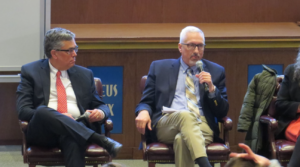WELLBeing Seminar Series: Ann Sussman

Image courtesy of the Nest
By Kat Kaderabek
The fathers of modern architecture are known for their distinctive styles. Walter Gropius utilizes smooth, angular walls. Le Corbusier is known for vast, spaced out pieces with unique curves. In her presentation “Designing for the Subliminal Brain,” Ann Sussman explained that this is not unintentional. It is born from the architects’ subconscious desire to construct their own minds.
The 21st century has brought a paradigm shift to the “Age of Biology,” and Sussman has identified that the understanding of the human mind can allow architects to gather more attention to their buildings.
“We figured out the genetic code for all human beings, we’ve solved the genome, and we have technology that can determine how people take in buildings without people realizing it,” Sussman said.
She went on to explain software programs like IMotions and 3M – VAS, which can visually track and predict where a subject will look when shown an image on a computer screen. The programs monitor everything from heart rate all the way down to the productivity of the sweat glands.
From this technology, the conclusion regarding facial recognition was created. Sussman explained that the brain is a face-sensing machine; we are built to look at people. In fact, her presentation demonstrated that the brain “reconstructs reality according to its own biological rules.”
When a person looks at a building, they will be more intrigued if there is some semblance of a face on the facade, like in traditionalist architecture, than if there was a dissimilar, blank, or modern facade.
This actuality extends beyond the field of architecture. Car designers build to the face-environment of the subliminal brain, which is why the front of vehicles often resembles a face. Companies like Apple now design for the “Endowment Effect,” because when customers touch something, they are more likely to desire to own it. These two concepts, touch and facial recognition, dictate more about people’s lives than they are consciously aware of.
Sussman even had her former students study cereal boxes. Sure enough, a smiley face was likely to appear somewhere close to the label on the most popular brands of cereal so as to speak to the unconscious part of the brain that looks for pleasure in faces.
How does this relate to architecture? Sussman had much to say about the dissociation of faces having to do with modern architecture, which leaves people feeling disconnected and cold.
Mies van der Rohe, Walter Gropius, and Le Corbusier were heavily influenced by World War I. PTSD rewires the brain, and Sussman made the claim that Gropius’s PTSD is in his architecture. She published an article about this theory that can be found here.
“With PTSD, you become ‘disembodied’…as do your buildings,” said Sussman.
“PTSD stops time. Your office recreates a trench, and traumatization is stress frozen in place. The interior wall construction of Gropius’s house mimics that of trench wall construction.”
Le Corbusier had autism spectrum disorder (ASD) as corroborated by several doctors. Because of hyperplasticity in an autistic brain, they ‘see’ the world differently than neurotypical brains. This, she proposes, could be an explanation for the vast, spaced out architecture of Corbusier that keeps viewers looking to and from every corner.
These examples culminated in her main point that “Modern architecture is a direct reflection of the World War I trench.” Her book, Cognitive Architecture, released in October 2020, delves into this argument further.
To drive home her point, Sussman reiterated that the conscious brain does not dictate our experience. Blank facades are completely ignored and colorfully painted walls are preferred to blank canvases.
“Our brain isn’t modern, our brain is 40,000 years old,” Sussman explained.
The technology of this age has come to manipulate this very factor, catering to every facet of the human attention span.
“This technology is frightening, the problem is it is already out the door,” Sussman said. “It is defining your world anywhere.”
Adobe has produced a plug-in for VAS technology – so now architecture students will now be able to influence the subliminal brain knowingly through their designs. Not only will large marketing companies have this technology, but students will as well. With this technology they will be able to subconsciously influence the emotions and reactions of clients everywhere.
Sussman concluded her disconcerting lecture with this statement: “We try to separate ourselves from the animal world, but it is false. We rely on our emotions. On the human face.”






